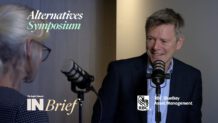Ringing the bell for low returns
The US sharemarket has compounded returns exceeding 18 per cent per year since the depths of the Global Financial Crisis. Despite the all-too-consistent prognostications in nearly every year since, that the market has become over-valued, investors have clearly been rewarded for taking risk.
Has this performance been driven solely by central bank policy, as many of the naysayers suggest? Or are earnings the true driver of the remarkable performance of not only the US but many other global sharemarkets? We may never know the true answer, but what we do know is that the next decade is unlikely to be anything like the last 12 years.
That is, if you believe what experts from every part of the world and financial markets are suggesting. The turning of the calendar naturally comes with an updating of the all-important return outlooks for the next 12 months, five years and ten years.
While one should always be wary paying too much heed to short-term forecasts, longer-term views can have some merit. But more importantly, they are a central input into the portfolio construction decisions we make on a daily basis, and which ultimately determine the lifestyle of our clients.
The death-knell for fixed income appeared to have been rung on multiple occasions in the last five or so years. I personally grew concerned about duration when the Australian government 10-year bond rate was at 3 per cent! In 2021, the forward-looking return expectations of both Robeco and Vanguard appear to confirm this; at least in their traditional, passive benchmark form.
According to Vanguard, it expects global fixed income to return between 1.3 and 2.3 per cent per annum for the next decade. Robeco is even more pessimistic, forecasting 0.75 per cent over the next five years. The driver is abundantly clear, and in line with what we saw in October 2021, being that inflation and even a slight normalisation in interest rates will see the 30-year-long duration tailwind dissipate.
It’s not much better for Australian bonds, with Vanguard forecasting 0.6 to 1.6 per cent returns. Similarly, the popularity of high-yielding investment-grade and so-called junk debt doesn’t appear to be offering the yield premium that we had all become used to.
The story doesn’t get much better in equities, with Vanguard’s valuation metric suggesting that not a single global equity market benchmark was in “undervalued” territory. According to its analysis, non-US developed market equities (read Europe and Japan), US smaller companies and US value stocks are just “fairly valued.” The S&P/ASX200 is “stretched,” trading at 70 per cent of fair value, while US and US growth are very stretched, nearing 100 per cent.
Naturally, the result is that forecast returns are significantly lower. The US is set to be the ultimate drag on portfolios, with the 1.9 to 2.9 per cent a year (over ten years) forecast returns among the lowest of any point in history. Non-US and emerging markets stand out as the best prospects for value, at 5 to 7 and 3.8 to 5.8 per cent a year respectively, with China clearly having an important role to play. For Aussie equities, the ten-year return assumption is 3.5 to 5.5 per cent a year.
So, what does this mean for portfolios? Is the fixed income allocation as we know it dead? Should advisers be replacing fixed income assets with cash? Or gold? Or even crypto? At what point does fixed income become attractive should the global economy return to trend in 2023?
Or, on the other hand, what if we have all become too negative due to the pandemic. Is this the beginning of another decade-long bull market? Earnings growth in the US and even Australia is among the strongest it has ever been, and policymakers have clearly identified the importance of smoothing the business cycle. That’s without mentioning the incredible boom in technological innovation occurring amid the pandemic.











